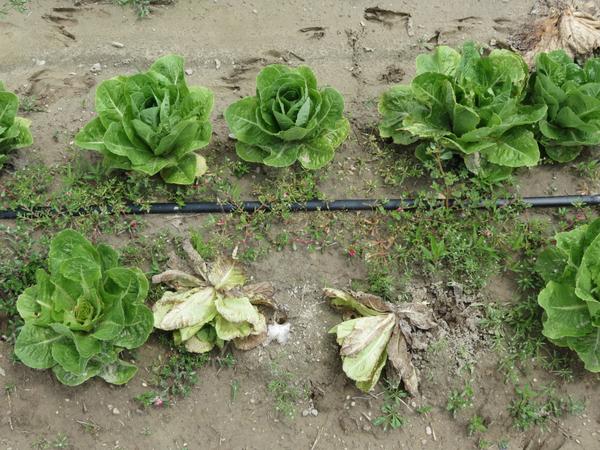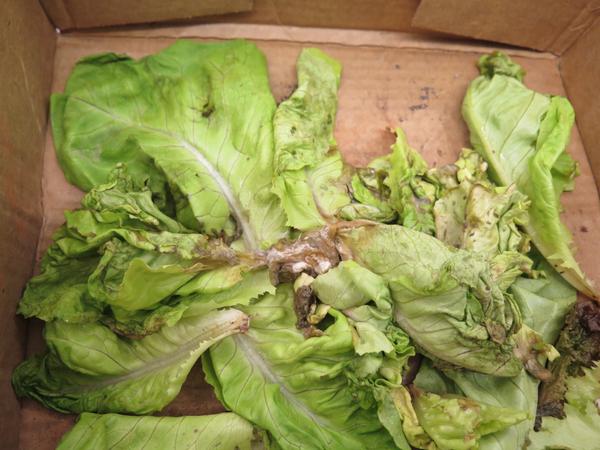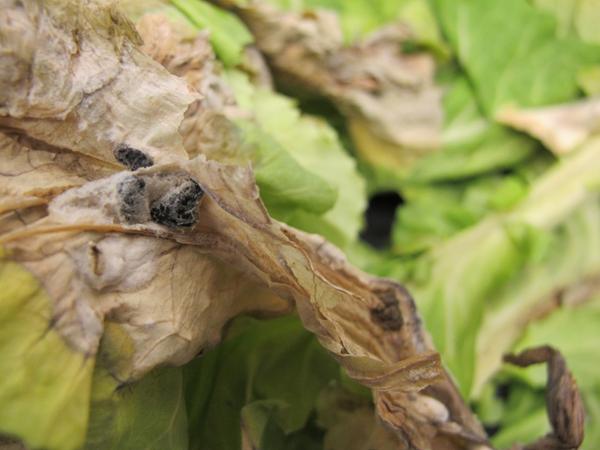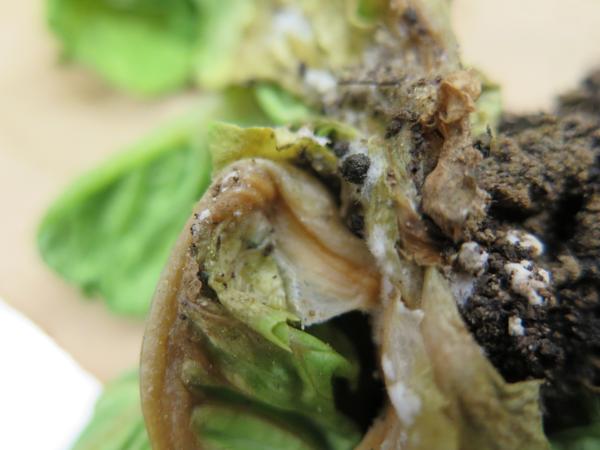Pathogen
Lettuce drop is caused by the fungal pathogens Sclerotinia sclerotiorum and Sclerotinia minor.
Host Crops and Plants
Sclerotinia sclerotiorum and S. minor have a wide host range infecting allium (onion, garlic), brassica (cabbage, broccoli), solanaceae (pepper, potato), cucurbits (cucumber, squash), lettuce, and sweetpotato crops. The broad host range of both pathogens significantly limits the efficacy of crop rotation. Cereals (maize, wheat, sorghum) are less susceptible to these pathogens. For more information about reported hosts for these pathogens, visit the USDA Fungus-Host Distributions Database.
Host Parts Affected
Affects the upper and lower leaves as well as the stems of lettuce.
Identification
Lettuce drop initially causes the lower leaves to wilt and drop to the soil surface (Figure 1). When moisture is present, a white mycelium can form (Figure 2) and sclerotia can develop (Figure 3 and Figure 4) where the leaf is in contact with the soil. S. sclerotiorum can also affect the upper leaves of the plant by airborne spores.
Favorable Environmental Conditions for the Disease
The disease prefers cool and moist conditions and wet soil.
Disease Transmission
The pathogen survives via sclerotia in the soil and in the case of S. sclerotiorum, by wind with sclerotia that produce ascospores.
General Disease Management
- Application of fungicides at early plant growth to control S. minor.
- Applications of fungicides to plants that are more mature to control S. sclerotiorum.
- Deep plowing to keep sclerotia from the soil surface.
- Crop rotation with non-hosts.
- Drip irrigation below the soil surface.
Disease Control for Conventional Growers
Fungicides may be required for control of lettuce drop, especially if disease was present in prior lettuce crops. Before disease appears, apply fungicides on a 14-day interval. For the latest fungicide recommendations for lettuce drop see the Southeastern US Vegetable Crop Handbook. Fungicide labels are legal documents, always read and follow fungicide labels.
| Active ingredient | Example product | Pre-harvest Interval (day) | Fungicide group |
|---|---|---|---|
| Boscalid | Endura | 14 | 7 |
| Fludioxonil | Cannonball | 7 | 12 |
| Iprodione | Rovral | 14 | 2 |
| Dicloran | Botran | 14 | 14 |
Useful Resources
- The NC State University Plant Disease and Insect Clinic provides diagnostics and control recommendations
- The Extension Plant Pathology Portal provides information on crop disease management
- The Southeastern US Vegetable Crop Handbook provides information on vegetable disease management
- The USDA Fungus-Host Distributions Database provides information about reported hosts for fungal and oomycete pathogens
Acknowledgements
This factsheet was prepared by the NC State University Vegetable Pathology Lab in 2016.
Publication date: March 21, 2018
Reviewed/Revised: Jan. 9, 2023
Recommendations for the use of agricultural chemicals are included in this publication as a convenience to the reader. The use of brand names and any mention or listing of commercial products or services in this publication does not imply endorsement by NC State University or N.C. A&T State University nor discrimination against similar products or services not mentioned. Individuals who use agricultural chemicals are responsible for ensuring that the intended use complies with current regulations and conforms to the product label. Be sure to obtain current information about usage regulations and examine a current product label before applying any chemical. For assistance, contact your local N.C. Cooperative Extension county center.
N.C. Cooperative Extension prohibits discrimination and harassment regardless of age, color, disability, family and marital status, gender identity, national origin, political beliefs, race, religion, sex (including pregnancy), sexual orientation and veteran status.




